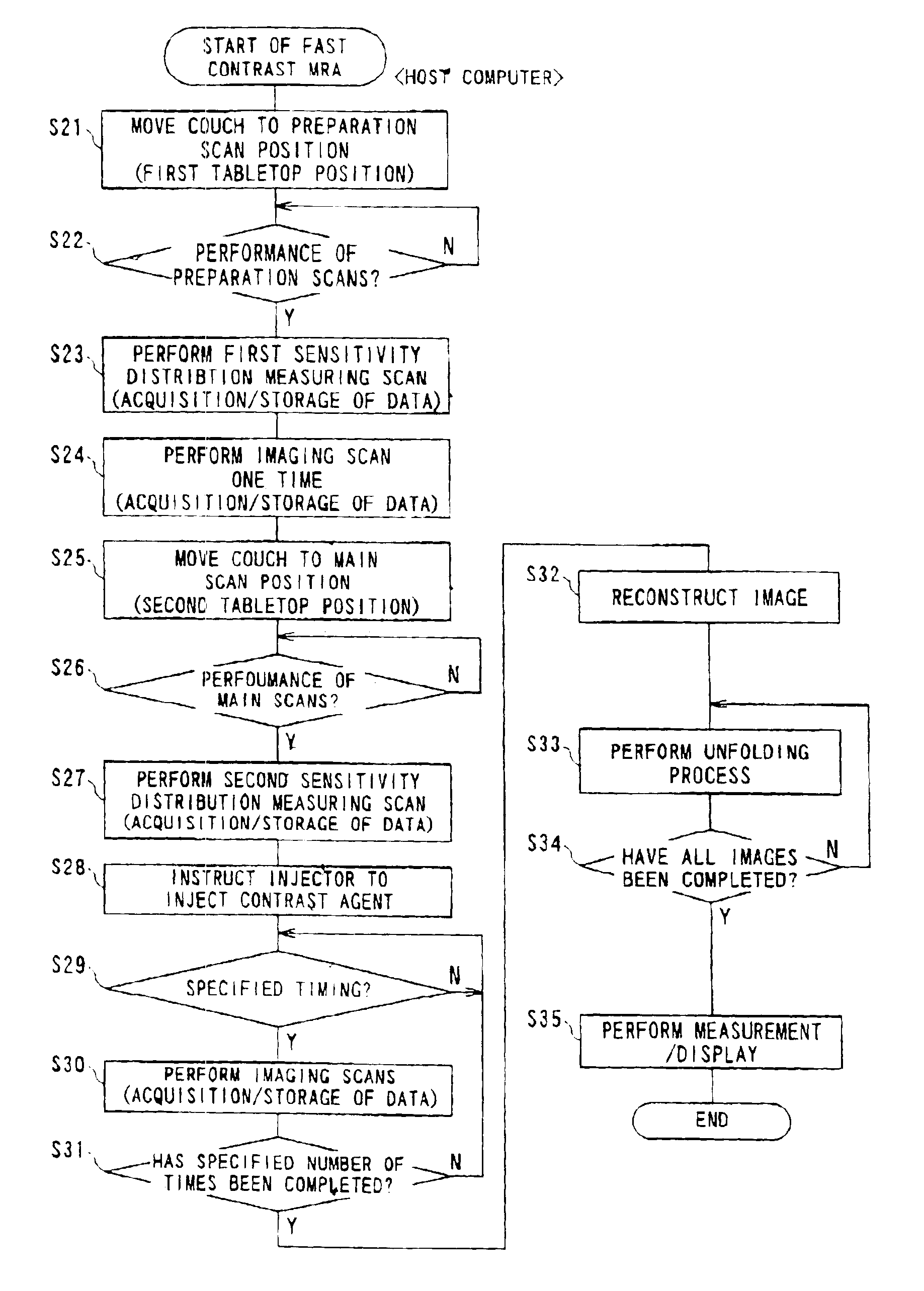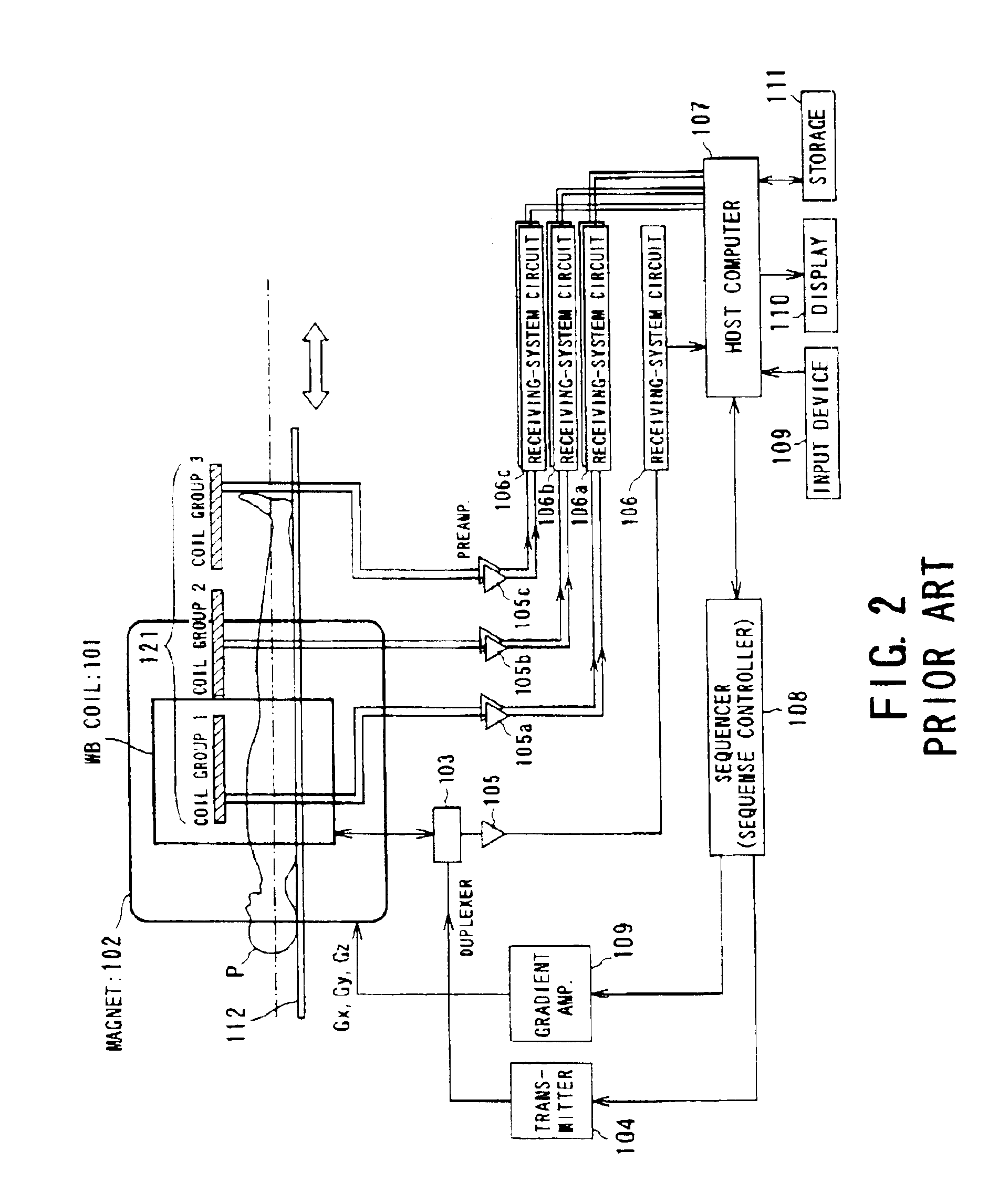Magnetic resonance imaging involving movement of patient's couch
a magnetic resonance imaging and patient technology, applied in the direction of measuring using nmr, magnetic variable regulation, instruments, etc., can solve the problems of lack of accuracy, complicated operation, and drawbacks of various types of conventional techniques, so as to speed up imaging, reduce operational work, and increase the accuracy of moving
- Summary
- Abstract
- Description
- Claims
- Application Information
AI Technical Summary
Benefits of technology
Problems solved by technology
Method used
Image
Examples
first embodiment
[0056]Referring to FIGS. 3 and 4, a magnetic resonance imaging (MRI) system of a first embodiment will now be described.
[0057]The magnetic resonance imaging system performs imaging using multiple RF coils with a moving couch (that is, a moving bed technique).
[0058]The configuration of this magnetic resonance imaging system is outlined in FIG. 3. This system has a couch unit on which a patient P as an object to be imaged, a static magnetic field generating unit for generating a static magnetic field, and a gradient generating unit for adding position information to the static magnetic field. The system also has a transmission / reception unit for transmitting and reception RF signals and a control / calculation unit in charge of control of the entire system and image reconstruction.
[0059]The static magnetic generation unit is proved with a magnet 1 constructed by employing for example a superconducting magnet and a static power supply 2 supplying current to the magnet 1. By these devices...
seventh embodiment
[0130]Referring to FIGS. 15 to 18, another embodiment of the present invention will now be described. Like the seventh embodiment, this embodiment is characterized by fast imaging based on changes in sensitivity distributions of one or more reception coils when a couch is moved.
[0131]Particularly one preferred embodiment of the fast imaging is fast contrast MR angiography (MRA) carried out under injection of an MR contrast agent in order to obtain images and / or measurement information in which its contrast effect is reflected.
[0132]The present embodiment will be described about a configuration in which the foregoing fast imaging is performed as the fast contrast MR angiography, but the configuration is not limited to such fast contrast MRA.
[0133]FIG. 15 shows a schematic form of a magnetic resonance imaging system capable of performing the fast contrast MRA. This system includes, as shown in FIG. 15, a whole-body (WB) coil 7T serving as a transmission coil and a single reception coi...
eighth embodiment
[0153]The imaging has been described with respect to an MRA in the above embodiment, but the imaging using a single reception coil can be carried out with no injection of a contrast agent. In such a case, the fast imaging may be performed on the sub-encoding method, although the reception coil is one in number. In other words, like the above eighth embodiment, a region to be imaged may be moved relatively to the one reception coil, so that a plurality of sets of echo data whose sensitivity to the reception RF coil is changed set by set are obtained. This is virtually equivalent to a configuration in which two reception coils are used.
[0154]Although the eighth embodiment has used one reception coil, this embodiment is able to adopt two or more reception coils. In cases the number of reception coils is increased, the speed of imaging can be doubled under a limitation that the same region can be imaged.
[0155]Further, a whole-body coil for transmission / reception can be used.
[0156]In the...
PUM
 Login to View More
Login to View More Abstract
Description
Claims
Application Information
 Login to View More
Login to View More - R&D
- Intellectual Property
- Life Sciences
- Materials
- Tech Scout
- Unparalleled Data Quality
- Higher Quality Content
- 60% Fewer Hallucinations
Browse by: Latest US Patents, China's latest patents, Technical Efficacy Thesaurus, Application Domain, Technology Topic, Popular Technical Reports.
© 2025 PatSnap. All rights reserved.Legal|Privacy policy|Modern Slavery Act Transparency Statement|Sitemap|About US| Contact US: help@patsnap.com



